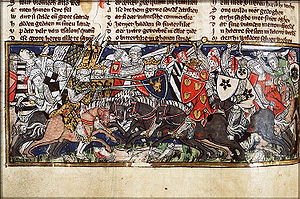
Back Batalla d'os Campos Catalaunicos AN معركة سهول كاتالونيا Arabic Katalaun döyüşü Azerbaijani کاتالون دؤیوشو AZB Битка на Каталаунските полета Bulgarian Emgann Campus Mauriacus Breton Batalla dels Camps Catalàunics Catalan Bitva na Katalaunských polích Czech Каталаун уйĕнчи çапăçу CV Slaget ved Chalons Danish
| Battle of the Catalaunian Plains | |||||||
|---|---|---|---|---|---|---|---|
| Part of the Hunnic invasion of Gaul | |||||||
 An anachronistic illustration of the Battle of the Catalaunian Plains depicting its combatants as armoured knights, from Jacob van Maerlant's Spieghel Historiael | |||||||
| |||||||
| Belligerents | |||||||
| Commanders and leaders | |||||||
| Strength | |||||||
| Modern estimates vary: see § Forces | Modern estimates vary: see § Forces | ||||||
| Casualties and losses | |||||||
| Modern estimates vary: see § Outcome | Modern estimates vary: see § Outcome | ||||||

The Battle of the Catalaunian Plains (or Fields), also called the Battle of the Campus Mauriacus, Battle of Châlons, Battle of Troyes[5] or the Battle of Maurica, took place on June 20, 451 AD, between a coalition, led by the Roman general Flavius Aetius and the Visigothic king Theodoric I, against the Huns and their vassals, commanded by their king, Attila. It proved one of the last major military operations of the Western Roman Empire, although Germanic foederati composed the majority of the coalition army. Whether the battle was of strategic significance is disputed; historians generally agree that the siege of Aurelianum was the decisive moment in the campaign[citation needed] and stopped the Huns' attempt to advance any further into Roman territory or establish vassals in Roman Gaul. However, the Huns successfully looted and pillaged much of Gaul and crippled the military capacity of the Romans and Visigoths. Attila died only two years later, in 453; after the Battle of Nedao in 454 AD, the coalition of the Huns and the incorporated Germanic vassals gradually disintegrated.
- ^ Jordanes, De Origine Actibusque Getarum, 38.199
- ^ Jordanes, De Origine Actibusque Getarum, 36.199
- ^ Kim, Hyun Jin (2013). The Huns, Rome, and the Birth of Europe. Cambridge: Cambridge University Press. p. 81.
- ^ Chronica Gallica 511, s.a. 451.
- ^ Magill, Frank Northen (1993). Magill's History of Europe. Grolier Educational Corporation. ISBN 978-0717271733.
© MMXXIII Rich X Search. We shall prevail. All rights reserved. Rich X Search